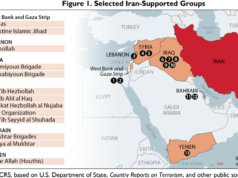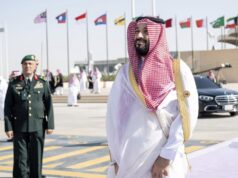Energy policy is typically viewed as the nexus of China’s booming relations with Persian Gulf countries. China’s energy security is linked directly to its oil imports from the Persian Gulf, but the reality of Chinese interests and policy toward the Persian Gulf is far more complex. An oil-focused, one-dimensional analysis underestimates China’s ambitions in this region, which is strategically important because of its geopolitical location, economic opportunities, and security issues. The Middle East is where Africa, Asia, and Europe come together and where the trade routes between China, India, and Europe converge. The Persian Gulf has become vital for China’s grand strategy against the backdrop of its ambitious “One Belt, One Road” initiative. As the Chinese dragon heads west, the Gulf countries are looking east. Considering the adaptive strategy undertaken by both sides, bilateral and multilateral relations are undergoing a major shift, from energy-centered ties to multi-dimensional strategic partnerships.
China’s Energy Quest in the Persian Gulf
Driven by the rapid growth of its economy and due to insufficient domestic oil reserves, China became a net oil importer in 1993. Since then, China’s overseas oil dependency rate has gone up steadily. As the largest oil importer and consumer in the world, China imported nearly 6.2 million barrels of crude oil per day in 2014, more than half of which was from Middle East. In particular, oil supply from the six Gulf Cooperation Council (GCC) countries accounted for around one-third of total Chinese oil imports.
With its booming economy, China’s energy trade with Persian Gulf countries carries crucial weight for China’s overall energy security. Saudi Arabia has 16 percent of the world’s proven oil reserves and is the largest exporter of total petroleum liquids. Despite having established diplomatic relations only in 1990, energy ties between China and Saudi Arabia have grown rapidly. In 2009, Saudi exports to China exceeded those to the U.S. for the first time, although partly due to the American domestic shale oil boom. In the last few years, Saudi Arabia has been China’s largest supplier of crude oil, supplying almost 1 million barrels per day in 2014, accounting for 16 percent of China’s total crude oil imports. As the largest economy in the region and the swing producer in the OPEC cartel, the Kingdom carries outsized influence. For a comparison, last year Oman supplied 620,000 barrels per day, Iraq supplied 573,000 barrels per day, and Iran supplied 546,000 barrels per day, ranking as the top providers to China after Riyadh.
The economics of oil have changed, but China is the Persian Gulf’s new best friend. The current plunge in the price of oil is due partly to the sluggish world economy, which is consuming less oil than markets had anticipated, and partly to OPEC itself, which has produced more than the market expected. Due to the shale oil revolution, the U.S. has completed around 20,000 new wells since 2010—more than 10 times the number drilled by Saudi Arabia—boosting its oil production by a third to nearly 9 million barrels per day, only 1 million short of Saudi output. The Saudi-American contest has tipped the world from a shortage of oil to a surplus, which benefits major oil consumers, primarily China.
It shouldn’t surprise anyone that, in a period of low prices, China is buying more oil than ever, and reportedly building up its strategic oil reserve to fulfill its goal of increasing the strategic oil reserve’s storage capacity from its current 37 days to 100 days by 2020. Moreover, the Iranian nuclear deal will catalyze an increase in Sino-Iranian bilateral oil trade. Chinese oil imports from Iran are projected to rise in 2015 to their highest levels ever, after temporarily declining in 2012 and 2013 due to the sanctions imposed by the United States and Europe.
New Silk Road and the Emerging Partnerships
Although oil is key to understanding China’s upgraded involvement in the Persian Gulf, China’s relationship with the region is much deeper and broader. China is embarking on a strategic approach to the Persian Gulf in the context of One Belt, One Road initiatives, which has evolved into a top national strategy in China. China is stepping up efforts to build two transcontinental New Silk Road frameworks that connect Asia, Africa, and Europe in trade, investment, infrastructure, and people-to-people exchange. Originally called the “Silk Road Economic Belt” and the “21st Century Maritime Silk Road,” the One Belt, One Road strategy was first introduced by President Xi Jinping in the fall 2013. In spring 2015, China’s top economic planning agency, the National Development and Reform Commission (NDRC), released a new action plan outlining key details of the strategy, highlighted by the building of land and maritime “economic corridors.” These are expected to be prioritized in China’s 13th Five-Year Plan, which will run from 2016 to 2020 and guide national investment strategy throughout that period.
The One Belt, One Road strategy has become China’s most important lofty design to engage with the greater Middle East. The strategy signifies a new stage of China’s “Going Out” initiative, which encourages Chinese firms to go abroad in search of new markets or investment opportunities. The first step is to increase regional connectivity by financing mega-infrastructure projects in countries along the routes, illustrated by the launching of a $40 billion Silk Road Fund and the $100 billion Asian Infrastructure Investment Bank (AIIB). Both are designed in part to complement and support the Belt and Road’s development by providing financial toolkits.
The New Silk Road is an important guide for China’s Middle East diplomacy, which indicates that China will play a more proactive role in the region. Undoubtedly, the Persian Gulf holds a unique position in China’s new policy framework. In the wake of Arab uprisings, the Gulf monarchies were pressured into boosting economic growth to maintain social stability. Thus, comprehensive and upgraded Chinese engagement will provide new impetus for Gulf economic growth. Rising youth employment is expected to smooth out the anti-government sentiment in major population centers with a significant proportion of young people. In this way, the initiative is expected to go a long way toward addressing underlying sources of instability.
The New Silk Road has received active responses from the Persian Gulf countries, embodied by their enthusiastic participation in the AIIB; Saudi Arabia, Iran, the United Arab Emirates, Jordan, Oman, Qatar, and Kuwait have all signed up as founding members. Membership in the AIIB guarantees these nations a fast track to Chinese investment funds and will unite them under a common economic interest together with China’s increasing commitments.
China’s New Engagement in the Region
China seems to be making inroads into the Persian Gulf exactly as the United States is reducing its political and security commitments to the region. The American “pivot” to the Asia-Pacific, coupled with China’s own economic interest in transferring its industrial overcapacity to its periphery, have helped push China into the Middle East.
President Barack Obama has accused China of being a “free-rider” in the Middle East, taking advantage of U.S. security while relentlessly pursing its own commercial interests, an accusation China rejects. For example, after the Iraq war broke out in 2003, China offered $25 million worth of humanitarian aid to Iraq. During post-war rehabilitation, Chinese enterprises helped Iraq rebuild its oil industry and restore Iraq’s national telecommunication service. China sees itself contributing to the region in a different way.
China has spread its ties to the Persian Gulf differently from the United States. The U.S. expended significant blood and treasure in the Middle East by waging the Afghanistan and Iraq wars with undesirable results. Not only has U.S credibility been undermined, but its support for political change in the region is perceived to be misplaced. The American drawdown is giving China an opportunity to fill the void. While China is confidently pushing forward the Belt and Road strategy by promoting trade, FDI, and financial engagement with the Persian Gulf, the United States, in stark contrast, lacks a comprehensive plan to promote economic growth in the region.
Notably, China increasingly attempts to engage with the region through two multilateral mechanisms. The first institutional framework is the China-Arab States Cooperation Forum (CASCF), which was launched in 2004 in Cairo. In June 2014, at the sixth Ministerial Conference of the CASCF, President Xi Jinping proposed the establishment of a “1+2+3” pattern of cooperation: energy cooperation as the core; then infrastructure construction plus trade and investment facilitation as two wings; and three new areas of high tech cooperation—nuclear energy, space satellites, and other new energy initiatives. In the next 10 years, President Xi underscored that efforts should be made to increase the bilateral trade volume from the $240 billion of 2013 to $600 billion. The second framework is the China-GCC Strategic Dialogue, initiated in 2010 and targeted at building a strategic partnership. While both sides agreed to accelerate the pace of establishing a free trade area, China asserted its desire to play a more active role in regional affairs, such as maintaining Gulf stability and combating the Islamic State.
Significantly, Sino-Gulf relations have moved far beyond the hydrocarbon sector, although that clearly remains important. An example is the substantial rise in Gulf-China capital investment and joint ventures over the past decade. A mutual upstream and downstream interdependence has formed as GCC sovereign wealth funds invest in Chinese oil refining and petrochemical industries and China increases its investment in GCC financial, construction, and energy sectors.
China’s Policy Dilemma and Future Challenges
In the context of China’s One Belt, One Road strategy, expect an expanding Chinese footprint in the Persian Gulf. Economically, China not only represents a huge and lucrative market for Gulf exports, but will also be a key driver for regional integration and infrastructure connectivity. Politically, China’s strict policy of non-interference in the internal affairs of other countries smooths relations even further. Moreover, the successful Chinese model of balancing economic development while maintaining political stability has an unmistakable and reassuring appeal for Gulf countries with similar aspirations. Finally, Gulf States see China’s rise as an opportunity to lessen their dependence on the West and diversify their foreign policy portfolio. China is framed as an essential and natural partner for those Persian Gulf states.
Despite China’s increasing engagement in the Persian Gulf, it lacks a clear, consistent, and comprehensive Middle East strategy. Beijing has issued numerous White Papers on many foreign policy issues and regions, including Africa and Latin America, but it has no such guidance on the Middle East or the Persian Gulf. China’s current cooperation with Persian Gulf states consists of strategic flexibility and maximizing opportunities, but that may prove insufficient. Second, the security dimension to China’s approach remains very limited. As China’s economic involvement grows, the safety of Chinese workers and businessmen has become a growing concern. In the Libya and Yemen wars, Beijing had to evacuate its citizens by sending warships. Presently, the rise of the Islamic State has also attracted hundreds of Chinese fighters, mostly Uighurs, to Syria and Iraq, greatly increasing Chinese counter-terrorism concerns, and Beijing increasingly feels the need to better protect the thousands of Chinese employees in the Iraqi oil and construction sectors. Finally, China has had difficulty in balancing relations between Iran and Arab countries. China was an integral member of the P5+1 that negotiated the Iran nuclear deal, but Arab concerns over Iran’s future nuclear project still exist. China and the GCC countries will have to work hard to ensure that Iran sticks to the commitments it made in the deal.
In conclusion, there is no doubt that China’s energy links with the Persian Gulf have been growing rapidly over the past decade, but it does not necessarily mean that China’s policy is wholly dominated by its need for energy. Looking into the future, China’s One Belt, One Road strategy will substantially shape its engagements with the region.
Dr. Cui Shoujun is the Director for the Center of Middle East and Africa Studies, associate professor and Assistant Dean of the School of International Studies, and research fellow of the National Academy of Development and Strategy at the Renmin University of China.





